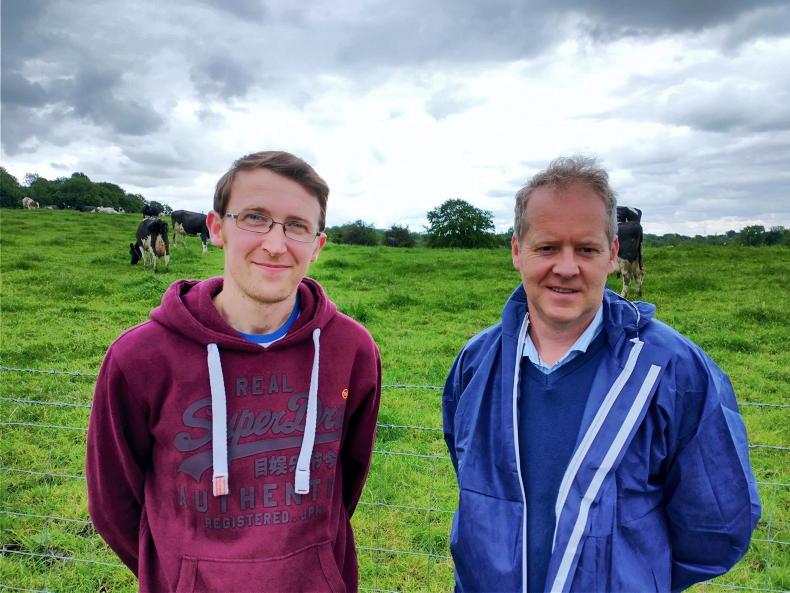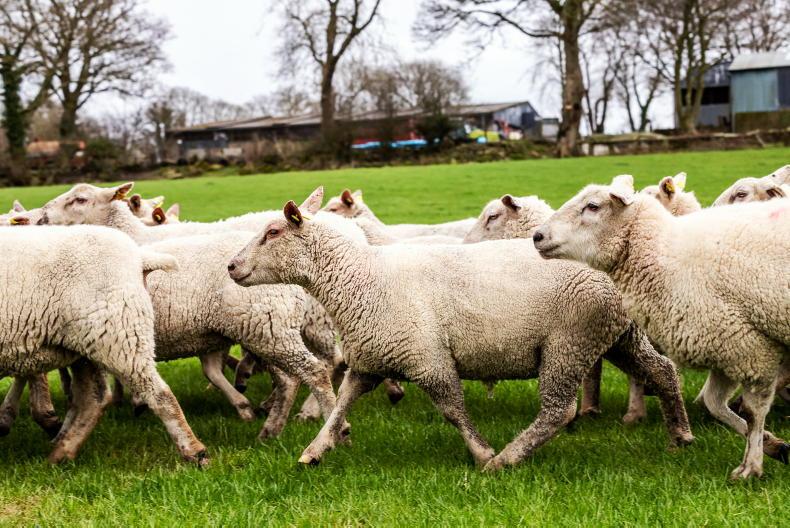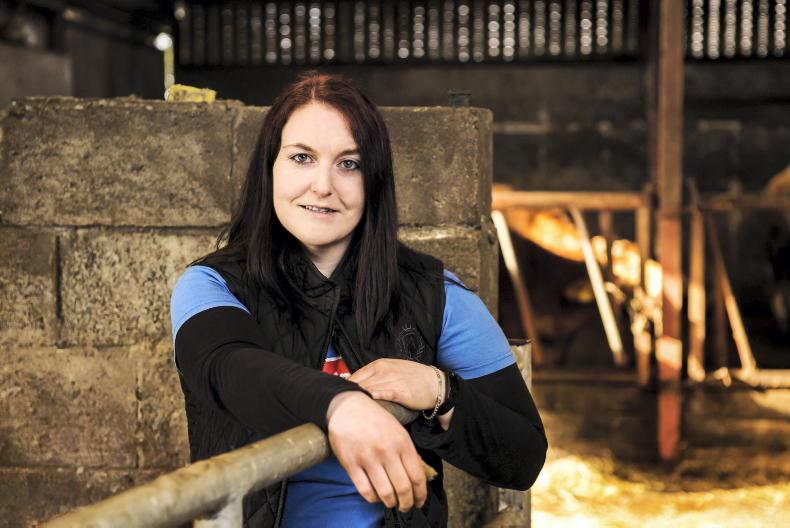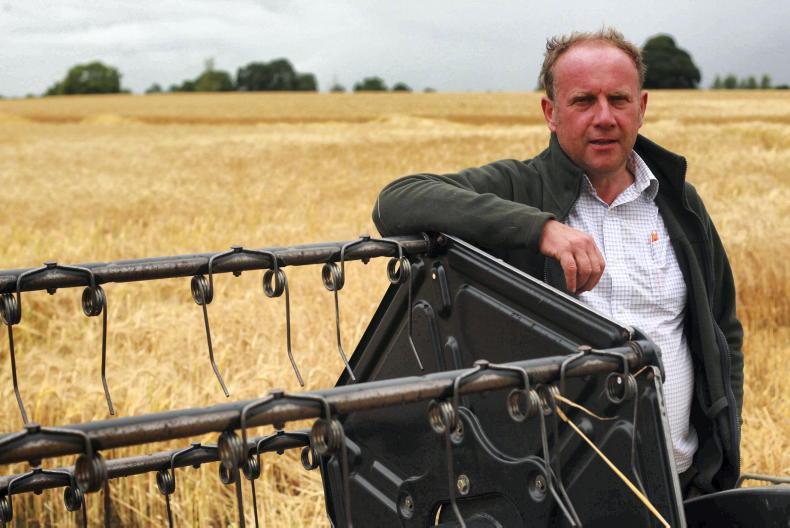While some dairy farmers have managed to make good quality first cut silage by the middle of May, for many others, particularly further west, it was the end of the month before they got their first cuts harvested.
Outlining the implications at a CAFRE event on the dairy farm of Philip and Adrian Kyle, Aughnacloy, Co Tyrone on Tuesday, CAFRE senior technologist Dr Aidan Cushnahan suggested a two-week delay will see quality significantly hit.
Assuming silage ME falls from 11.5 to 10.6MJ/kg of dry matter, he estimates that for a cow producing 30 litres it will require an extra 2.5kg of concentrate per head to make up the energy gap. “That works out at 45t of concentrate in a 100 cow herd over a six month period,” said Cushnahan.
He suggested that the aim should now be to try to make some good quality second and third cut silage, but in the meantime, get the first cut analysed and a feed plan prepared.
The Kyle farm is no different to many others further west, with silage not harvested until the end of May, and with an extra silage pit now full. However, they do have a pit of good quality second cut from 2021 (ME 11.5), which will be fed when cows are at peak output this winter.
The other option is to mix the first and second cut in a TMR, however, the Kyles prefer to keep the system simple, and instead feed silage in blocks and meal during the winter in out-of-parlour feeders.
There are 90 mainly Holstein type cows on the 79ha farm, split into two groups, with a high group still in at night.
Precision
Attention to detail on the farm is exceptional, with cows fed to yield and averaging 8,564 litres on 2.14t of concentrate in 2020. Milk from forage was 3,800 litres. There is no set calving pattern, although summer months are avoided. Calving index currently stands at 372 days, with replacement rate at 16%.
Grass is measured weekly, and that information used to inform decisions about meal feeding etc. “I am up 1,000 litres per cow since I started measuring grass. It is impossible to know how to feed a cow in the summer otherwise. It is the best paid two hours in the week,” suggested Philip Kyle.
He said that before he started measuring he was going into covers that were too high. The aim now is covers around 3,000kg of dry matter (DM) and graze down to 1,700kg of DM.
Philip is now mid-way through the fourth rotation, and topping paddocks for the first time. There is no pre-mowing done, except if a paddock was getting ahead of the cows (over 3,330kg).
To date in 2022, the farm has grown 5.6t DM/ha, which is about 0.75t more than the same period in 2021. However, growth rates have taken a dip, with Philip measuring growth of 56kg DM/ha at the start of the week, which is slightly behind demand of 69kg DM/ha/day.
But with first cut area to come into the rotation it will take the pressure off the grazing platform.
Read more
What to do with stemmy grass
Dairy Management: how much fertiliser for second cut?
While some dairy farmers have managed to make good quality first cut silage by the middle of May, for many others, particularly further west, it was the end of the month before they got their first cuts harvested.
Outlining the implications at a CAFRE event on the dairy farm of Philip and Adrian Kyle, Aughnacloy, Co Tyrone on Tuesday, CAFRE senior technologist Dr Aidan Cushnahan suggested a two-week delay will see quality significantly hit.
Assuming silage ME falls from 11.5 to 10.6MJ/kg of dry matter, he estimates that for a cow producing 30 litres it will require an extra 2.5kg of concentrate per head to make up the energy gap. “That works out at 45t of concentrate in a 100 cow herd over a six month period,” said Cushnahan.
He suggested that the aim should now be to try to make some good quality second and third cut silage, but in the meantime, get the first cut analysed and a feed plan prepared.
The Kyle farm is no different to many others further west, with silage not harvested until the end of May, and with an extra silage pit now full. However, they do have a pit of good quality second cut from 2021 (ME 11.5), which will be fed when cows are at peak output this winter.
The other option is to mix the first and second cut in a TMR, however, the Kyles prefer to keep the system simple, and instead feed silage in blocks and meal during the winter in out-of-parlour feeders.
There are 90 mainly Holstein type cows on the 79ha farm, split into two groups, with a high group still in at night.
Precision
Attention to detail on the farm is exceptional, with cows fed to yield and averaging 8,564 litres on 2.14t of concentrate in 2020. Milk from forage was 3,800 litres. There is no set calving pattern, although summer months are avoided. Calving index currently stands at 372 days, with replacement rate at 16%.
Grass is measured weekly, and that information used to inform decisions about meal feeding etc. “I am up 1,000 litres per cow since I started measuring grass. It is impossible to know how to feed a cow in the summer otherwise. It is the best paid two hours in the week,” suggested Philip Kyle.
He said that before he started measuring he was going into covers that were too high. The aim now is covers around 3,000kg of dry matter (DM) and graze down to 1,700kg of DM.
Philip is now mid-way through the fourth rotation, and topping paddocks for the first time. There is no pre-mowing done, except if a paddock was getting ahead of the cows (over 3,330kg).
To date in 2022, the farm has grown 5.6t DM/ha, which is about 0.75t more than the same period in 2021. However, growth rates have taken a dip, with Philip measuring growth of 56kg DM/ha at the start of the week, which is slightly behind demand of 69kg DM/ha/day.
But with first cut area to come into the rotation it will take the pressure off the grazing platform.
Read more
What to do with stemmy grass
Dairy Management: how much fertiliser for second cut?










SHARING OPTIONS